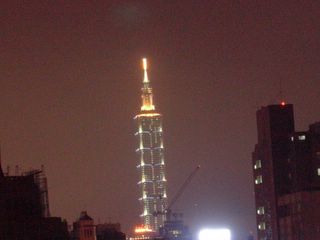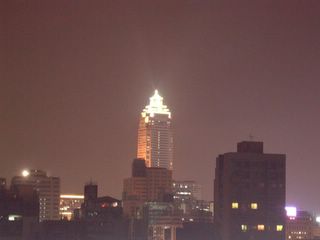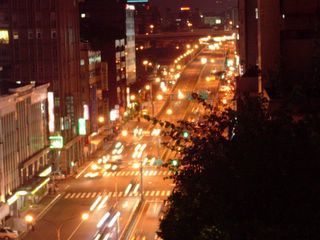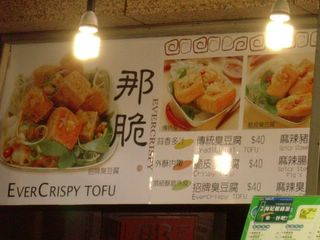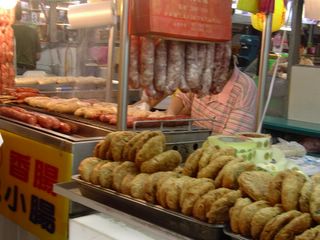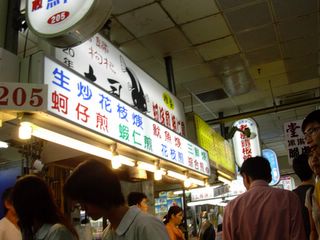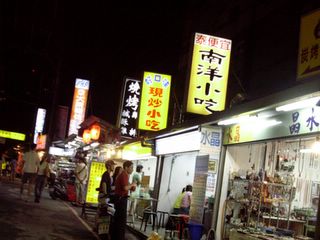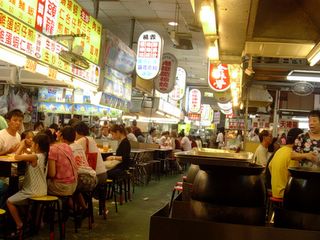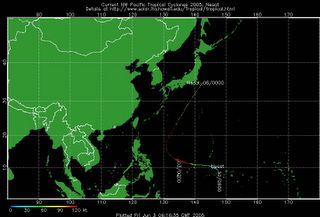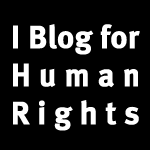Saturday, June 04, 2005
June 4, 1989
To the people who have died and are dying in the struggle for human rights and dignity in China...
On this day, I remember watching the TV as a five year old.
Images of darkened streets, soldiers and students.
Tiananmen became a camp site, with flags and banners.
I remember seeing a white statue, shining, screaming.
But I also remember the brave man stopping a column of tanks.
Blood spilled onto the streets.
16 years later, I imagine Tiananmen today.
It must be quiet, with the occassion crowd of tourists and passerbys.
I wonder how many are plain-clothed policemen.
I wonder how many have already been 'ushered' away.
I know there are many who have been arrested.
I know many have gone.
Is the cause of freedom less valuable than profits and business?
Blinded by greed the world worships
Cheap goods, low quality products,
Some, churned out by prisoners and children.
The past is readily twisted, forgotten and erased,
By all who embrace China's new breed of capitalist communism.
And this is the country that is due to host the next Olympics.
And this is the country with a veto power in the UN.
And this is the country that threatens its neighbours.
And this is the country investors rush to exploit its potentials.
And this is the country the EU is thinking of selling weapons to.
And this is the country which many have dubbed will be the next superpower.
Power built on tyrrany and terror
Erodes like a sandcastle at the sea.
Going on vacation
I'll be leaving tomorrow and going on vacation with my parents in the east of the country. Primary destination will be Green Island, located some 30km out to sea away from Taiwan main island. It's supposed to be very beautiful there, and my brother has recommended it many times already. Will finally pay it a visit! The whole region there, and along the coast of Eastern Taiwan is one of the many protected national senic areas/national parks. It should be quite a sight, the mountains and cliffs against the big blue Pacific.
To many, Green Island is a place where political prisoners were kept during the era of Martial Law. Sort of like Taiwan's Alcatraz. But from what I've heard and read, there is so much more...dolphines, whales, coral reefs, unique rock formations, hot-spring by the sea...
I'll see when I get there.
A further stop will be in Taitung (台東, 'East Taiwan')...where there is a famous hot-spring resort, and lots of sea food.
Intrigued what I'll discover and see.
East Coast National Scenic Area (東部海岸國家風景區)
http://www.eastcoast-nsa.gov.tw/en/
Green Island (綠島)
http://www.eastcoast-nsa.gov.tw/en/travelinfo/travel/travel_area.php?travel=5
The city at night
Always many things to choose from, from traditional delicacies of seafood, sausages, vegetables, to Japanese, Indian, Thai, Vietnamese kitchen; from fried, stir-fried, boiled, squeezed, to foods of all shapes and sizes. And all for budget prices. For around NT$30-80 (approx. €1-2), you can savour all sorts of special receipes probably not found elsewhere. Some foods are really exotic (also read disgusting to some people), as many internal organs of animals are consumed here. Taiwanese people believe that when you eat the organ of another, you also 'boost' (補, meaning heighten the functions) your own organ...So, eating a pig's heart will improve your heart, for example, and eating the testicles of chicken will... (you guess). Maybe not hygenic sounding, but then people have been eating these things for thousands of years, and are still thriving. As they say here, anything with four legs can be eaten (except a table).
Eating as a culture is a habit and hobby here. People eat to develop friendships, and the first thing people think of when going out is to eat. It's the most effective and suitable way to get to know someone. Actually the first thing people say when meeting another is ask: '吃飽了沒?' (have you eaten?) It's a sort of greeting, that is engrained in the way people interact with one another.
And in this country, eating is never a big problem, whatever time of the day. My parents hardly ever cook at all, as it's probably much cheaper and saves hassle to eat outside. I've been here almost a week, and only had two meals at home.
Beside food, there are many alleys and streets around the market famous for its cheap merchandise. There you can found all sorts of things, from shoes to LCD screens, from even more food to CDs. Many are of course imitations of famous brands and labels from afar, but then at a fraction of the price. There are also fortune-tellers who sit around temples and attract many worried about their prospects in life, love and career.
After that I went to my dad's apartment in central Taipei. I took the bus and noticed that the bus was fitted with LCD screens, broadcasting advertising and the news. Coincidentally, the Netherlands Tourist Board broadcast a short film about Holland...the usual attractions of tulips, wooden shoes, windmills and Keukenhof. That sense of being 'home away from home' again.
The world outside as the bus rushed through the streets of Taipei was so colourful and bright, even though it was past nine. So many cars, motorcycles, pedestrians, against a background of yellow street lights, flashing neon-light kanban (看板, Japanese word for ad signs), of illuminated skyscrapers and public parks. A city full of life, at night.
From the rooftop of the six storey building, I tried to view the city in its colourful dress of lights and splendour. The Shin Kong Mitsukoshi Life Tower shown like a beacon towards the west, while in the east the newly opened Taipei 101 glowed like a torch in the night sky.
When does this place ever sleep?
Friday, June 03, 2005
Sun after the storm
As Typhoon Nesat (尼沙) nears the island, the front systems in the north and south are affected, and torrential rainfall was expected. Now, she has become a medium sized tropical storm (scale 7), with 180km/hr winds. Every year typhoons cause billions in damges, and already in mountain areas roads have been broken by flash floods and landslides. Poor planning and random development and cultivation also means that the soil is eroded in many places, increasing the risk of damage when it pours. The rain fell for hours, and hours, causing some localised flooding in the eastern and southern parts of the country. But now, the storm seems to be over. I don't think the typhoon will directly 'invade' the island (this is the term they use on the news). For strange reasons, Nesat approached Luzon in the past few days, and then suddenly turned 90 degrees and is now heading towards Japan.
Thank goodness for that, since I'll be going away with my parents to Green Island (綠島) in the East Pacific. Let's just hope Nesat does decide to change her mind again, and ruin our trip.
Something ridiculous in the news today. In Taiwan, it is custom to commemorate the dead by preparing meals and placing it before them. So in crematoriums you have rows and rows of small altars dedicated to the deceased, usually with a small name plate and a picture, and in front of that bowls of rice, dishes of vegetables, meat and fish. An usually incense would be burning night and day. This food in Taiwanese is literally translated as 'food at the end of the feet' (腳尾飯)---I think it denotes food served at the 'end of the road'. It is a custom not to eat this food again, since it has been served to the deceased, so has a negative energy in it (death is negative, or very ying 陰). What normally happens is that the food is either thrown away (which I think is a real waste), or fed to animals. Unfortunate people who eat this 'contaminated food' will become sick, and will have bad luck for one year.
Some investigative journalism has revealed that at the Taipei public crematorium, employers collect the food and then sell it to small restaurants (usually ones you find on street) for a windfall profit! These people, called 'black-hearted cockroach' (黑心蟑螂, 'black hearted' because of their dispicable actions, and 'cockroaches' because they creatures crawl on food if left on table too long) can make up to NT$ 60,000 (approx. €1,500) a month with this. A city councilor renowned for his skills at capturing the decays of society filmed this and sent it to the big media houses. Within moments, new channels blarred with the scanal, as reporters rushed to the crematoriums, small restaurants, and the city hall for questions. You can see the typical mentality of the media when such scandals break loose: 'Whose fault is it??'
It is very shocking, and shows how many unscupulous Taiwanese people would do anything for profit.
Look before you eat.


Source:http://www.goes.noaa.gov/guam/GUAMIR.JPG
Taiwan is the little long, potato shaped island on the top left corner
Thursday, June 02, 2005
Earthquake!
It's a frightening feeling. THe moment the quake strikes you completely loose control and time slows as you watch things move uncontrollably around you, youself included. Dogs start to bark moments just before. Sometimes, you can hear the thunderous roar of the ground beneath you vibrate, as the shock wave is sent through the ground and travels further. The noise, movements and aftershocks is really traumatising. You still shake, after the earthquake has passed.
My mum who was already asleep lept out of bed, and quickly opened the door. Standard procedure. This island is prone to earthquakes daily, most are not felt, but dozens every year are enough to be felt (ie above 3 on the Richter scale). 24hrs news channels quickly pointed to the lights and cameras sawying above the recording studios. Reporters rushed to the Central Weather Centre in central Taipei . News here is measured by the minutes. Within 5minutes, reporters standing outside beamed live images back and started to report latest figures, facts and damage. In Taiwanese legends, there is a bull which lives under the ground. It's usually very tame and quiet...but every now and then, it has to flip its body over and turn its back. An earthquake thus is also called ' ground bull turning its body' (地牛翻身). In 1999. an earthquake of 7.9 hit central Taiwan, and killed almost 2500 people. The force literally lifted whole mountains and shifted them metres away from where they were. Sometimes, when a really big one comes, you see ants appearing in nature rushing to and fro in search of a place to go. And people say the sky actually darkens hours before the quake happens. It was a gloomy day whole day today. Forecasters predict other quakes in the days ahead.
Apparently it was a 6.0 earthquake 12km off the coast of Ilan (宜蘭), in North-Eastern Taiwan (around 1 megaton of energy, or same as around 31 Nagasaki nuclear bombs). The east coast is where most tremors occur, as it lies on the ridge of the Philipine and Eurasian tectonic plates. The tremor was a 4 here in Taipei, and because this city is in a flat basin, the strength is magnified.
I don't think there were any injuries at all. No tsunami warning either.
Just people shaken, and stirred from their sleep.
Wednesday, June 01, 2005
Looking back
I was in central Taipei today. Needed to upgrade the laptop I took with me, and also pick up something for my parents. I took the MRT (metro), which goes straight to Taipei Main Station within 15minutes. The scenery was the same as I remembered it, same as in any great big city. People minding their own business, many grey sad-looking faces, as people rush in and out of the train. Announcements are made in three of the main languages of Taiwan, Mandarin Chinese (guo2 yu3 國語 ‘country language), Taiwanese (tai2 yu3台話 ‘Taiwan tongue), and Hakka (ke4 jia yu3客家話 ‘guest family tongue’). And for the foreigners, English too. Though small, the people and cultures of this country is a rare blend, and each ethnic and cultural group thrives alongside one another. Or at least, this is so now.
Once I upgraded the laptop, I had to go to a street famous for its ‘collecting gifts’. Stock owners can collect gifts from the companies. These gifts can range from more shares, to electric shavers, ovens, handbags and pens. Gift-giving is an integral part of the culture. And to attract customers, companies need to give attractive gifts. When I arrived, the whole street was lined with people queing to exchange vouchers for gifts.
In Taiwan, ownership of shares is one of the highest per capita in the world. New-found wealth in the heydays of the 1980s and 1990s when the economy grew at an average of 9% and the quite equal distribution of incomes meant that people had money to spare. And spare money was usually invested in the stock market. Anyone with a bank account to do this. All you have to do is go to one of the many securities exchange bureaus (證券交易所) around the island, and buy/sell whatever and however much you want. These bureaus are big air-conditioned offices, with rows and rows of monitors, tracking and analysing the movements all registered companies on the Taiwan Weighted Index (TAIEX). Daily transactions are usually hundreds of billions of Taiwan dollars (€1= NT$38 / US$1 =NT$34). There are also foreign investors pouring in as well. It’s big business here, and some do it as a full-time profession. Often, middle-aged people sit in the cool bureaus and doze off in front of the screens. By their expression, you can tell whether the stock market has been doing well that day. They may look old, but their minds are clear. They must be. Some people can win millions within hours. But, the risk is also loosing millions or more in the same period of time
After that I went to the part near by, and was drawn toward the National Taiwan Museum (臺灣博物館). I had read about the exhibition ‘Taiwan in Maps’ sometime before. It’s been years since I last came here. Last time, I remember an old, damp and run-down museum, and before it was called the ‘Provincial Museum of Taiwan’ (省立臺灣博物館).
The change of name is significant here, and follows the change of the political climate. Taiwan only became a democracy in 1986. For years, Taiwan was under the dictatorship of Chiang Kai-Shek (蔣介石) after he fled to the island in 1949, together with his Kuomintang (KMT, Chinese Nationalist Party國民黨). The arrival of the Chinese meant a 40 year Martial Law (戒嚴), a measure Chiang and his cronies imposed and labelled as the ‘Temporary Provisions of Effective During Period of National Mobilisation for Suppression of the Communist Rebellion’ (動員戡亂時期臨時條款). By ‘Communist Rebellion’, they meant the takeover of mainland China by Mao Zedong and the Communists. Chiang wanted to use Taiwan as a springboard to retake the Chinese Mainland, if need be with American support. To do this, the militarization of society and people was necessary, while absolute rule, the suspension of the democratic process and civil obedience was key. For decades, Taiwanese people and culture were repressed, and treated as second-class citizens in their own country by the Nationalist Chinese regime. The KMT hoped (and still hopes) to one day return to China, so its policies and propaganda was focused on fulfilling its ideology and ambitions. By the early 1990s, Martial Law was lifted. The government finally realised that it was impossible to ever ‘retake’ China, so liberalised and democratised. The first ever Taiwanese president, Lee Teng-Hui (李登輝) was appointed in 1992, re-elected in 1996. In 2000, for the first time ever, a peaceful transition of power took place as the long-time opposition Democratic Progressive Party (DDP, 民進黨) came to office, with President Chen Shui-Bian (陳水扁) at the helm. He was re-elected in 2004.
Ever since the DDP government took power, it has been insistent on reviving Taiwanese culture and identity. Indeed, most of its supporters are those who support an independent Taiwan. Through education, political, media, business reforms Taiwanese identity is reasserting itself and manifesting itself in all walks of life. Speaking Taiwanese, for a long time forbidden and liable to a fine, is now really ‘in’. it means more than a language, but has become associated with identifying with this island as your home and motherland. But then, as anywhere, identity and cultural politics is not without its dangers.
The exhibition at the museum was appropriate, in the sense that it was an attempt to rectify the past, and to be more assertive about being ‘Taiwanese’. What does it mean to be ‘Taiwanese’? Ironically, the display ‘Taiwan in Maps’ is called ‘Are you lost?’ (你迷路了嗎?) Maps can help you find the way. But the exhibition displays maps of the island from the early 16th Century, from the Manchu Dynasty, from the Japanese period, from the KMT dictatorship, to today. Tracing maps through time, I think the message is to be more at home.
It was fascinating to see. There were maps from when Europeans sailors first chartered the waters around here. Thanks to the Portuguese sailors, Taiwan was discovered by the 1550s, and named Ilha Formosa (Beautiful Island, 福爾摩沙). By the 1720s, Taiwan’s position has a trade post was enhanced. The Dutch had settled in Southern Formosa, near today’s Anping (安平), and built Fort Zeelandia, on a little sandbank the locals called Tayouan (台灣 ‘terrace bent’). This little sandbank was crooked, and much higher than the sea and land around it, hence the name; a name which would later become the island’s. The Spanish settled in the north, near today’s Tamshui (淡水), and built Fort Domingo (known as ‘Red Hair City’, after the foreigners who apparently were red-haired, 紅毛城). They interacted with the Formosan Aborigines, co-opted chiefs to exploit the land and labour. Sugar cane was imported to be locally cultivated, while deer skin of the Formosan Deer (梅花鹿 ‘plum blossom deer’, named after the unique patterns on the hide) was exported elsewhere. Slaves from the Southern China were imported to work for the European powers. Before Europeans arrived, the island was divided among 20 different tribes. Those who lived in the great plains of the west were known as the Pingpu (平浦) aborigines, totalling around 10 in total (eg. the Ketagalan, the Taokas, the Pazeh). Others lived in the mountains in the central (eg. the Bunun, the Atayal tribes), southern (eg. the Rukai, the Paiwan) and eastern parts (the Amis), some lived near rivers and lakes (the Sau), while yet others lived on islands in the Pacific (the Yami). Headhunting, voodoo magic, singing and prayers for rain and harvests echoed around the island. According to the BBC, some researchers have recently found evidence that Austro-Polynesians may have one time originated from Formosan aborigines.
At the height of the Manchu Dynasty, the territories of Formosa and the Pescadores (Fisherman’s Islands, today Penghu澎湖) were incorporated into the Chinese Empire in 1684. As an island separated from the Chinese mainland, the Manchus sent its ‘ruffians’ and other petty criminals to exile together with the ‘red savages’ (紅番) and pirates that already lived on Formosa. At the same time, Chinese from the Fukien (福建) migrated across the ‘ Black Water Canal’ (Formosa Strait, 黑水溝), in search of a more hospitable and fertile land. Hakka communities from central China also settled in Taiwan, to escape from prosecution and to found a land for themselves. So, Taiwanese people do have their roots and cultural links in China. But, intermarriages between ‘ruffians’, aborigines and migrant communities have blended to produce distinct cultural background, heritage and experience. Together, vibrant communities and road connecting the south and north had developed. Interesting, Taiwan first developed in the south, around the where the Dutch first settled, and spread northward, linking the settlements and harbours around where I live now.
The Opium War against the British (1860s), and Sino-French War (1870s) forcedly opened many ports to Europeans powers once more. Traders settled in and around the northern port of Tamshui and Keelung (雞籠 ‘Chicken cage’), and exploited Formosa’s geographic position at the cross-roads of the Asia-Pacific a stopover for journeys in all directions. By then, one of the first railway networks in Asia had been built, and an electricity and telegraph lines were laid down. The Americans, late in the colonial race, actually offered to buy Formosa.
The Japanese gained control of the islands in 1895, as a result of Sino-Japanese War. It became a colony for fifty years, and in those years industry flourished. Mining of the island’s gold, coal, copper, marble oil and natural gas began, while redwood, plums, mustard seeds (for wasabi), all sorts of teas and rice were exported back to Japan. At one time, Formosa produced 70% of the world’s camphor oil (樟腦油), necessary at the time for manufacturing explosives and ointments. As the first overseas possession of Japan, it wanted to use Formosa as a model for others to see that it was a ‘benign’ colonist. The Japanese laid down much of the modern infrastructure which would later form the foundations of the Taiwan ‘economic miracle’.
While I was walking around the museum, a group of school children were on a field trip. I looked at them and thought how so many things have changed in the past years. It would be unthinkable a decade or so ago to speak of wanting to know Taiwan, wanting to speak the language, to be identified as Taiwanese. My parents and many others grew up with KMT/Chinese indoctrination, lies and myths, with schoolbooks which taught about the history, people and geography of China, but nothing about Taiwan. Isn’t it strange to be living somewhere, but not know anything about your home? Now, there’s change, there’s progress. And it’s signs like this which show that there is hope.
Whether I am lost? I seem to have found my roots in the museum.


Time Magazine once did a special report about beetle nut (bin lan2 檳榔) culture in Taiwan, and doubed it the Taiwanese chewing gum. It's a sort of small palm, and usaully harvested, cleaned and processed to be chewed. When chewed, it releases a light hallucinant and caffeine, which makes it addictive. But then your mouth also becomes red, because of the juice. Scantily dressed girls can be seen on the highways and byways of the country, selling these nuts. Foreginers come here also to see this strange phenomenon.

